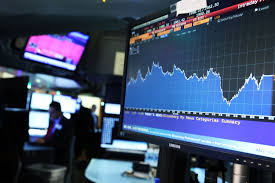There’s a New Way to Hedge Against Wild Swings in the Stock Market

If it feels like the stock market is particularly volatile these days, you’re not wrong, but you’re not exactly right either.
The political backdrop is certainly prompting some wild days. Stocks rose on Tuesday after the U.S. Commerce Department relaxed restrictions on Huawei Technologies that had halted the Chinese phone company’s purchases of U.S.-made parts. Even as negotiations continue, investors saw protectionist policies stemming from the U.S. China trade dispute threatening economic growth, and stocks fell accordingly, led by the tech sector.
However, it turns out this isn’t a particularly volatile period by historical standards.
“The markets keep bouncing back,” said Craig Birk, chief investment officer at Personal Capital, an investment adviser with $ 9 billion in assets under management. “They are looking at [the volatility] as a buying opportunity.”
Birk argues that compared to historical norms, the volatility actually isn’t that dramatic. “There’s a misperception that we have heightened volatility,” Birk said. “We were conditioned by 2017, which was out-of-the-ordinary in terms of a lack of volatility. We became conditioned to expect that kind of calm. This year the volatility is up, but day to day, it’s calm.” There have been just 3 days this quarter that the S&P 500 moved more than 1 percent, while over the last 20 years, it happened closer to 30 percent of all trading days, Birk says.
Are there safe havens? Birk points out that the utility sector “has become negatively correlated with the market,” and may be an area to diversify. Many investors are loaded up with U.S. tech companies, but “if you just want to ride the rally, tech is where it’s happening.” Health care still acts as a haven even though the sector has taken a beating, he said. Investors should be diversified in growth stocks and defensive sectors. “Make sure you haven’t put your chips on one side of the table,” he said.
Don’t look to bitcoin as a hedge, Birk advises. “It’s still very speculative in nature,” he said. “Typically that’s not a sign as a long-term hedge. If there’s a correction, bitcoin will get hit hard, if not worse.”
For investors looking to take advantage of market swings, Quadratic Capital Management is offering investors a new play off interest rate volatility. The Quadratic Interest Rate Volatility and Inflation Hedge exchange-traded fund (Ticker IVOL), which launched last week, seeks to hedge against rising inflation and to potentially profit from the steepening yield curve (the spread between short-term and long-term interest rates).
It’s actively managed and invests in Treasury inflation-protected securities, or TIPS, and over-the-counter fixed-income options in its strategy to offer inflation protected income and hedge against fixed income volatility.
The asset management firm was founded by Nancy Davis, who was previously head of credit, derivatives and OTC trading at Goldman Sachs Group’s proprietary trading desk. She said the largest OTC markets are accessible only to large, sophisticated institutions. The Quadratic ETF gives average investors “access to a market they couldn’t access on their own,” she said, and she sees it as a portfolio diversifier.
Another way to get exposure to market tumult is through exchange traded funds that measure implied volatility of large cap stock options on the S&P 500 Index such as the ProShares VIX Short-Term Futures exchange traded fund (Ticker: VIXY). Volatility rises when stocks decline and these funds are used as a hedge against short-term moves in the market.
Investors will keep their focus on trade compromises, interest rates and corporate earnings for signs to keep buying. But over the next month? “It’s pretty clear it’s all about trade,” Birk said. A trade deal could certainly push stocks higher. But in a state television video clip on Monday, China’s President Xi Jingping asked citizens to join a “new long march” – a reference to a pivotal point in the history of the Communist Party – that was seen as turning up the nationalistic rhetoric.
It may be a long march back to calmer markets for investors, too.
More must-read stories from Fortune:
—The winners and losers in a $ 1 trillion buyback year
—Too many companies are paying too much for stock buybacks
—This year’s tech IPOs are raising $ 2.2 billion on average
—How to invest during a trade war
—Listen to our new audio briefing, Fortune 500 Daily
Don’t miss the daily Term Sheet, Fortune‘s newsletter on deals and dealmakers.

